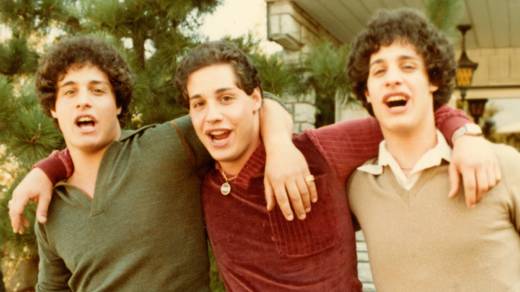Now in his grizzled late fifties, Bobby Shafran is an affable, ordinary fellow whose life ran away from him back in 1980, when the nineteen-year-old freshman drove his beat-up Volvo to enter community college in upstate New York. He was puzzled at being effusively greeted by fellow students who called him Eddy. It quickly transpired that he was a dead ringer for another student at the college named Eddy Galland, who turned out to be the twin Bobby never knew he had. The discovery got into the local press, and soon a third lookalike, David Kellman, turned up. The identical triplets, all adopted by different families, were joyfully reunited and only too happy to take on the fairy-tale collective identity bestowed on them by the television talk shows. Which is when things began to really get weird, and not only because neither the boys nor their adoptive parents had known that other siblings existed.
If Three Identical Strangers — an extraordinary documentary about the three brothers by British director Tim Wardle — were only about the deathless allure of identical offspring, it would still be a riveting tale. The demonstrable sameness of siblings hatched from the same egg excites the friction between our insistence on individual uniqueness and our desire for a mirror-image Other who will understand and defend us and keep us company forever. Or so the fantasy goes.
It didn’t hurt that the three boys, as we see in home movies and clips from the television talk circuit, were telegenic teddy bears with liquid brown eyes, masses of black curls and bashful, camera-ready grins. Paraded before an enthralled public, they dutifully showed up in the same outfits, crossed their legs in unison on demand, confessed under pressure to having the same taste in women. All had wrestled in high school, and wasn’t it amazing that they all had adopted sisters? Bobby, Eddy, and David made the nightclub rounds, got married, opened a restaurant together. Their celebrity status was predicated on their sameness, and for so long as they could play along with the packaging, it was all so super-cute. Until it wasn’t, and here the boys’ story, or stories (the plural bursts with significance), went from amazing to incredible to very, very dark.
On its face, Three Identical Strangers presents as a straight-ahead documentary with the usual mix of home and media footage, re-enactments, and testimony from friends, family, other interested parties as well as two of the siblings themselves. In fact, the film is an artfully constructed investigative narrative structured to give us the sense of discovering, along with the boys and their families, several layers of buried secrets and lies that blighted their adult lives. If ever a story called for multiple narratives and deep digging into the past it’s this one. The triplets kept shedding identities and starting over in cataclysmic renewal — once at birth, again when they met and got swept into a media circus, and then, as new information peeled back their histories apart and together, in a reckoning that undid one of them and did serious damage to the others.


